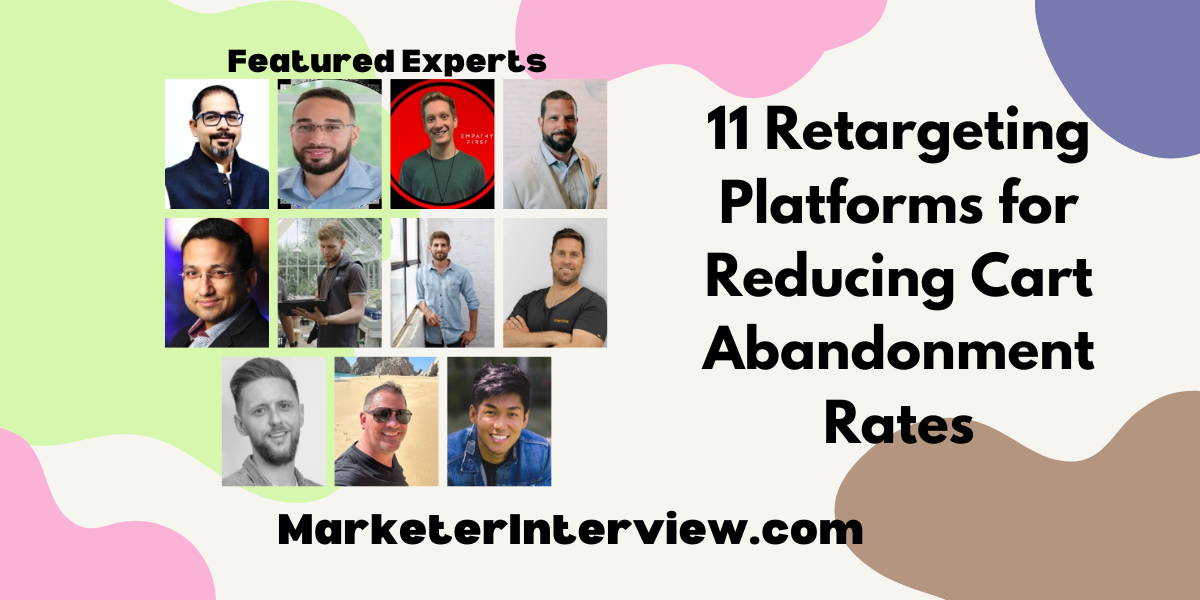11 Retargeting Platforms for Reducing Cart Abandonment Rates
Are you struggling with high cart abandonment rates? In this insightful Q&A, leading experts such as a founder and a Vice President of Marketing share their strategies. The first expert reveals how Smartly’s A/B Testing optimizes retargeting, while the final insight comes from a Chief Growth Officer discussing Meta’s retargeting ad delivery optimization. Discover a total of eleven actionable insights to transform your cart recovery efforts.
Want to get quoted in MarketerInterview.com content just like this? Apply to become a contributor today!
Contents
- 1 Smartly’s A/B Testing Optimizes Retargeting
- 2 Google Ads RLSA Boosts Cart Recovery
- 3 Facebook Custom Audiences Cuts Abandonment
- 4 Facebook Dynamic Retargeting Increases Conversions
- 5 Facebook Dynamic Product Ads Convert Hesitant Buyers
- 6 AdRoll’s Personalized Ads Drive Conversions
- 7 HubSpot CRM Enhances User Interaction
- 8 Klaviyo’s Customization Improves Recovery Rates
- 9 Mailchimp Emails Recover Abandoned Carts
- 10 SaleCycle’s Behavioral Marketing Re-engages Customers
- 11 Meta Retargeting Optimizes Ad Delivery
Smartly’s A/B Testing Optimizes Retargeting
Smartly’s retargeting platform helped me reduce cart abandonment for our premium stock analysis packages by around 25%. I found success by segmenting users based on how far they got in the checkout process and sending different message types—like educational content for early abandoners versus discount codes for those who made it to payment. What really worked was their A/B testing feature that let me optimize email subject lines and ad creative until we found what resonated best.

Adam Garcia, Founder, The Stock Dork
Google Ads RLSA Boosts Cart Recovery
We’ve had surprising success using Google Ads RLSA combined with customized landing pages for abandoned carts. I set up different messaging for users who left during our VPN service checkout versus our streaming guide purchases, which helped boost our recovery rate to around 25%. The key was keeping the retargeting window short—just 3-7 days—and offering a small discount only on the second retargeting touchpoint.

Tyler Hall, Developer, TROYPOINT
Facebook Custom Audiences Cuts Abandonment
Facebook Custom Audiences has been a game-changer for us at Zentro Internet, helping cut our cart abandonment by 32% last quarter. We found success by creating different audience segments based on how far users got in the checkout process—someone who just viewed a plan gets different messaging than someone who started signing up. What really moved the needle was showing testimonials from happy customers in our retargeting ads, especially to those who abandoned right before the final step.

Andrew Dunn, Vice President of Marketing, Zentro Internet
Facebook Dynamic Retargeting Increases Conversions
Facebook’s dynamic retargeting worked wonders for reducing cart abandonment. When we saw one of our top products being left in carts, we ran ads showing the product, its benefits, and an offer for free shipping.
The results were immediate. Within a week, we saw a 30% increase in conversions for that product. It was a simple yet powerful reminder of how tailored messaging can re-engage customers and encourage them to finalize their purchase.

Dinesh Agarwal, Founder, CEO, RecurPost
Facebook Dynamic Product Ads Convert Hesitant Buyers
In my experience at Lusha, Facebook’s Dynamic Product Ads have been our most effective retargeting tool, cutting cart abandonment by about 23% last quarter. I found success by segmenting audiences based on browse time and cart value, then creating specific messaging for each group—like offering free shipping for carts over $50, which really helped convert those hesitant buyers.

Yarden Morgan, Director of Growth, Lusha
AdRoll’s Personalized Ads Drive Conversions
We’ve found that using AdRoll has been particularly effective in reducing cart abandonment rates for our clients. AdRoll is a retargeting platform that offers a comprehensive suite of tools specifically designed to re-engage potential customers who have left items in their shopping carts without completing the purchase.
One of the key reasons AdRoll stands out is its ability to deliver personalized, targeted ads across multiple platforms, including social media channels and the web. This multi-channel approach ensures that potential customers are reminded of their abandoned carts wherever they spend their time online, increasing the likelihood of conversion.
AdRoll’s dynamic ads feature is especially beneficial. It allows us to create ads that automatically display the exact products customers left behind, alongside personalized messaging that can include incentives like discounts or free shipping. This level of personalization is crucial for capturing the attention of potential buyers and encouraging them to return and complete their purchase.
Another advantage of AdRoll is its robust analytics and reporting capabilities. We can track the performance of our retargeting campaigns in real time, gaining insights into which strategies are most effective at reducing cart abandonment. This data-driven approach enables us to continuously optimize our campaigns for better results.
Moreover, AdRoll integrates smoothly with various e-commerce platforms, making it easy to implement and manage campaigns directly from the tools we already use. This integration ensures that our retargeting efforts are seamlessly aligned with the rest of our marketing strategy.
Leveraging AdRoll to address cart abandonment has helped us significantly boost conversion rates for our clients. Its comprehensive features and focus on personalized retargeting make it an invaluable tool for turning potential losses into successful sales.

Josh Matthews, Director, LogicLeap
HubSpot CRM Enhances User Interaction
When it comes to reducing cart abandonment, I’ve found implementing a “high tech, high touch” approach to user interaction highly effective. Our company relies on a strong CRM system, HubSpot, which allows us to automate re-engagement workflows while keeping the personal touch. This not only facilitates seamless communication with customers but also ensures any initial issues in the purchase process are promptly addressed.
In our early stages, we used customer feedback to overhaul our user experience, focusing on simplicity and efficiency. We found that personalized follow-ups after initial cart abandonment, where our team would reach out and discuss any potential concerns, significantly boosted our retention rates. This approach, though resource-intensive, helped convert one-off visitors to loyal, repeat customers, and reduced issues with abandoned carts.
Additionally, we prioritize the feedback loop with our customers, ensuring they have a platform to share their experiences. By refining our product interface and backend processes, we have streamlined the checkout flow, leading to hassle-free transactions. This proactive customer engagement allowed us to refine issues at an early stage and align our offerings with customer expectations, ultimately improving conversion rates.

Klaviyo’s Customization Improves Recovery Rates
As an e-commerce business, we’ve found Klaviyo to be a standout tool for tackling cart abandonment. Its easy-to-use customisation options enable us to design eye-catching, tailored email templates that really speak to our audience.
The platform’s A/B testing capabilities allow us to fine-tune strategies, ensuring every email is as effective as possible.
Additionally, Klaviyo’s powerful product feed feature is invaluable, allowing us to dynamically showcase items visitors have shown interest in directly within our abandoned cart emails. This level of personalisation has driven significant improvements in our recovery rates, making Klaviyo an essential part of our re-targeting toolkit.

David Mathews, Company Director, FitstrapsUK
Mailchimp Emails Recover Abandoned Carts
Retargeting cart abandoners through email marketing platforms like Mailchimp has been remarkably effective. We specifically designed follow-up emails that are triggered shortly after a cart is abandoned, offering personalized incentives like free shipping or limited-time discounts. This approach has not only brought customers back but has also resulted in a 20% improvement in completed sales for our martial arts clients.
To ensure these follow-up strategies are successful, I dive deep into user analytics to identify where there’s friction in the checkout process. For example, we’ve found that highlighting customer reviews in the retargeting emails effectively builds trust, convincing potential buyers to return and finalize their purchase. These emails are crafted to align with the buyer’s journey, addressing their needs at every touchpoint.
An example of this was when we used targeted messaging based on user behavior, which helped a fitness center we work with significantly lower their cart abandonment rates. The key was addressing abandonment reasons—like unexpected fees—and using data-driven insights to customize the messaging. This realigned their strategy and boosted their conversion rates dramatically.

Ron Sell, Chief Executive Officer, Spark Membership
SaleCycle’s Behavioral Marketing Re-engages Customers
In my experience, SaleCycle has been instrumental in reducing cart abandonment rates. This platform specializes in behavioral marketing, offering solutions like on-site and email remarketing to re-engage customers who leave without completing a purchase. By sending personalized messages and reminders, SaleCycle effectively brings shoppers back to finalize their transactions.
Another effective tool is CartStack, which focuses on recovering abandoned carts through targeted email campaigns. It tracks lost conversions and sends timely reminders to customers, encouraging them to return and complete their purchases.
Both platforms have proven successful in addressing cart abandonment by leveraging personalized communication strategies to re-engage potential customers.

Runbo Li, Co-founder & CEO, Magic Hour
Meta Retargeting Optimizes Ad Delivery
Regarding reducing cart abandonment rates, I’ve found Meta (Facebook) retargeting to be our most powerful platform. The dynamic product ads have been especially effective at bringing back shoppers who left items in their cart, showing them exactly what they were interested in across Facebook, Instagram, and the broader Audience Network. The precision of Meta’s targeting capabilities has consistently outperformed other platforms we’ve tried.
While we also use Google Ads and Criteo with decent results, Meta’s machine-learning algorithms have proven particularly adept at optimizing ad delivery to users most likely to complete their purchases. Their system gets smarter over time at identifying the best times and placements to show our retargeting ads, which has led to higher conversion rates than other platforms.
The cost-effectiveness of Meta retargeting has been impressive, typically generating a 3-4x return on our ad spend. Since implementing a strategic Meta retargeting campaign, we’ve managed to reduce our cart abandonment rates by approximately 25%. The platform’s ability to automatically optimize campaigns and reach potential customers across multiple touchpoints has made it our go-to solution for tackling cart abandonment.

Sachin Puri, Chief Growth Officer, Liquid Web
Want to get quoted in MarketerInterview.com content just like this? Apply to become a contributor today!






